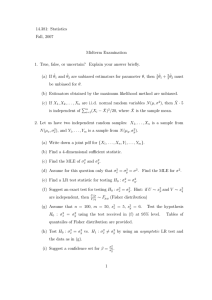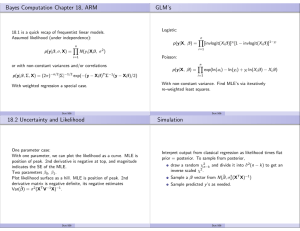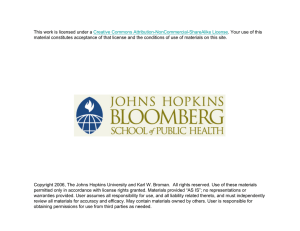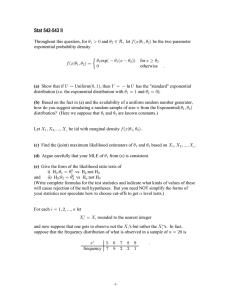Interval estimation of the stress-strength reliability with independent normal random variables
advertisement
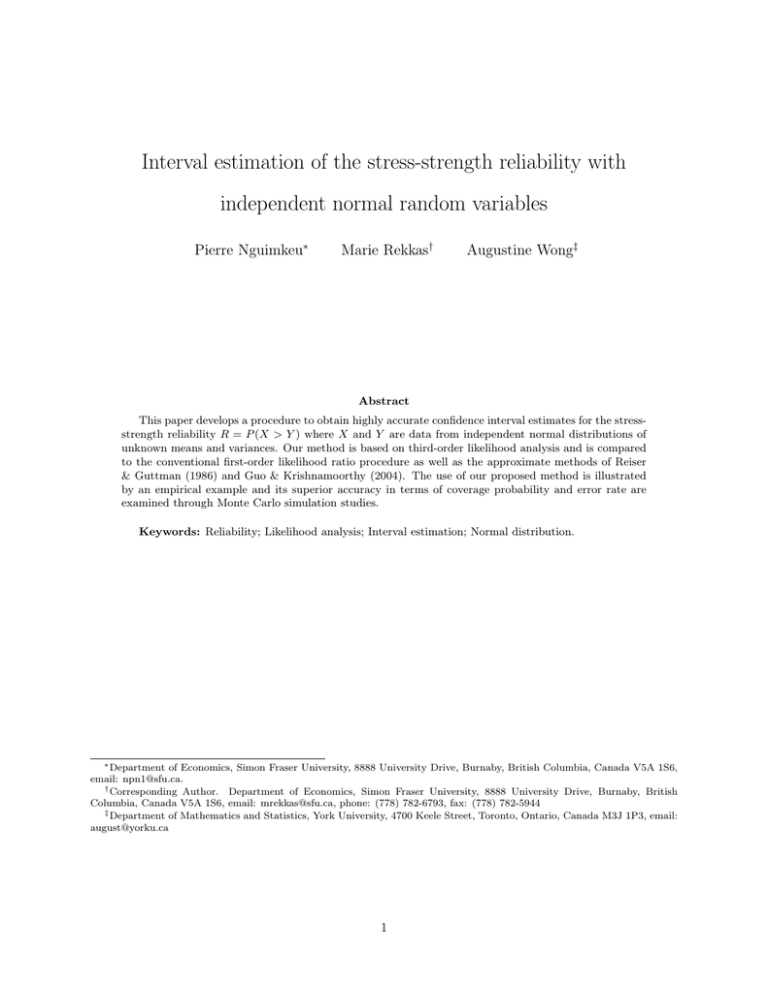
Interval estimation of the stress-strength reliability with
independent normal random variables
Pierre Nguimkeu∗
Marie Rekkas†
Augustine Wong‡
Abstract
This paper develops a procedure to obtain highly accurate confidence interval estimates for the stressstrength reliability R = P (X > Y ) where X and Y are data from independent normal distributions of
unknown means and variances. Our method is based on third-order likelihood analysis and is compared
to the conventional first-order likelihood ratio procedure as well as the approximate methods of Reiser
& Guttman (1986) and Guo & Krishnamoorthy (2004). The use of our proposed method is illustrated
by an empirical example and its superior accuracy in terms of coverage probability and error rate are
examined through Monte Carlo simulation studies.
Keywords: Reliability; Likelihood analysis; Interval estimation; Normal distribution.
∗ Department of Economics, Simon Fraser University, 8888 University Drive, Burnaby, British Columbia, Canada V5A 1S6,
email: npn1@sfu.ca.
† Corresponding Author. Department of Economics, Simon Fraser University, 8888 University Drive, Burnaby, British
Columbia, Canada V5A 1S6, email: mrekkas@sfu.ca, phone: (778) 782-6793, fax: (778) 782-5944
‡ Department of Mathematics and Statistics, York University, 4700 Keele Street, Toronto, Ontario, Canada M3J 1P3, email:
august@yorku.ca
1
1
Introduction
Consider two independent random variables X and Y . The functional R = P (X > Y ), usually referred to
as the stress-strength reliability, is of practical importance in many fields including medicine, biostatistics,
genetics (Schwartz & Wearden 1959), engineering, reliability (Harris & Soms 1983), psychology, and quality
control (Kotz, Lumelskii & Pensky 2003). For example, in clinical studies, if X is a response of a treatment
group and Y is the response of the control group, then R measures the effectiveness of the treatment. In
a reliability study, where X is the strength of a system and Y is the stress applied to the system, 1 − R
measures the chance of failure of that system.
This paper considers statistical inference for R = P (X > Y ) when the observed data X and Y are drawn
from independent and unknown normal distributions. Simonoff, Hochberg & Reiser (1986) explained that
this is one of the most common situations encountered in parametric estimation of reliability. Inference about
R in this setup has been considered by many authors. The approximate method of Reiser & Guttman (1987)
is a generalization of the methods proposed by Enis & Geisser (1971), Church & Harris (1970) and Mazumbar
(1970) in several respects. Weerahandi & Johnson (1992) proposed inferential procedures for R based on
the generalized p-value approach while Guo & Krishnamoorthy (2004) constructed lower confidence limits
for R based on the approximate procedure of Hall (1984) for the difference of two normal variates. Unlike
the above authors, the method we propose is based on the recent advances in likelihood based asymptotics
which possess third-order accuracy.
The rest of paper is organized as follows. Section 2 discusses existing methods including the approximate
method of Reiser & Guttman (1986), the approach of Guo & Krishnamoorthy (2004) and some first-order
likelihood based methods. Section 3 develops our proposed third-order procedure. An empirical example
using clinical data as well as a Monte Carlo simulation study are examined in Section 4. Section 5 summarizes
this paper.
2
Existing methods for interval estimation of P(X>Y)
Let X and Y be two independent random variables such that X ∼ N (µx , σx2 ) and Y ∼ N (µy , σy2 ). With
observed samples x = (x1 , . . . , xn ) and y = (y1 , . . . , ym ), the log likelihood function of θ = (µx , σx2 , µy , σy2 ) is
given as
l(θ) = l(µx , σx2 , µy , σy2 ) = −
n
m
X
n
m
(xi − µx )2 X (yj − µy )2
log σx2 −
log σy2 −
−
.
2
2
2σx2
2σy2
i=1
j=1
(1)
By solving for the first-order conditions, ∂l(θ)/∂θ = 0, we can obtain the overall maximum likelihood
estimator (MLE) of θ denoted by θ̂ = (µ̂x , σ̂x2 , µ̂y , σ̂y2 )0 , with
2
n
µ̂x =
1X
xi
n i=1
µ̂y =
1 X
yj
m j=1
n
σ̂x2 =
m
1X
(xi − µ̂x )2
n i=1
m
σ̂y2
=
1 X
(yj − µ̂y )2 .
m j=1
d θ̂) = j −10 (θ̂) where
An estimated variance of the maximum likelihood estimator is Var(
θθ
n/σ̂x2
0
0
0
4
2
0
n/2σ̂x
0
0
∂ l(θ)
=
jθθ0 (θ̂) = −
0
∂θ∂θ θ=θ̂ 0
0
m/σ̂y2
0
0
0
0
m/2σ̂y4
(2)
(3)
is the observed information matrix evaluated at θ̂.
2.1
An approximate confidence interval estimation of R=P(X>Y)
The stress-strength reliability R = P (X > Y ) when X and Y are independent normal random variables is
given by
R = P (X > Y ) = Φ(ψ),
(4)
µx − µy
ψ = ψ(θ) = q
σx2 + σy2
(5)
where
and Φ(·) is the cumulative distribution function of the standard normal distribution.
By the Invariance Principle, the MLE of R can be obtained from θ̂ by
µ̂x − µ̂y
b = Φ(ψ(θ̂)) = Φ q
b = Φ(ψ)
R
.
σ̂x2 + σ̂y2
(6)
Since Φ(·) is a monotonically increasing function of ψ, by finding a confidence bound for ψ, the confidence
bound for R = Φ(ψ) is trivially obtained. Thus, in the rest of the paper, we focus on ψ as our main parameter
of interest.
With the variances not being assumed equal, as in the Behrens-Fisher problem, there exists no exact
b only approximate distributions have been proposed in the literature. However, it is
distribution for ψ;
well-known that
µ̂x − µ̂y ∼ N
σ̂x2
∼ χ2n−1
σx2
σ̂y2
m 2 ∼ χ2m−1
σy
n
σy2
σ2
µx − µy , x +
n
m
!
s2x
∼ χ2n−1
σx2
s2y
(m − 1) 2 ∼ χ2m−1 ,
σy
(n − 1)
3
(7)
(8)
(9)
where s2x and s2y are unbiased estimators of σx2 and σy2 defined by1 :
n
s2x =
m
1 X
(xi − µ̂x )2
n − 1 i=1
s2y =
and
1 X
(yj − µ̂y )2 .
m − 1 j=1
As shown by Reiser & Guttman (1986), the distribution of ψb can be derived as a Behrens-Fisher type
approximation that takes the form of a noncentral t-distribution:
√
where
√
√
M ψb ∼ td ( M ψ),
(10)
M ψ is the noncentrality parameter with
M=
σx2 + σy2
σx2 /n + σy2 /m
(11)
and the degrees of freedom d is given by the relation
d=
(σx2
+
σy2 )2
σy4
σx4
+
n−1 m−1
!
.
(12)
The Reiser & Guttman (1986) procedure is a generalization of several methods that exist in the statistical
literature. For example, the procedure extends the method of Enis & Geisser (1971), who only considered
the case where m = n and σx = σy . It also generalizes Church & Harris (1970) and Mazumdar (1970), who
treated the case where µy and σy are known. M and d are unknown but are estimated by s2x and s2y in their
formulas. An approximate (1 − α)100th percentile of ψ can therefore be obtained by numerically solving
p
i
h p
cψ ≤ M
cψb = 1 − α. Hence, the (1 − α)100% confidence interval for ψ can be obtained.
M
for ψ in P tdb
Likewise, the approach proposed by Guo & Krishnamoorthy (2004) also requires the computation of
noncentral t distributions, noncentrality parameters and non-integer degrees of freedom. An approximate
1 − α percentile of ψ can be obtained from the Guo & Krishnamoorthy (2004) method by solving
q
q
q
q
b
b
c
c
c
c
min P tdc1
M1 ψ ≤ M1 ψ , P tdc2
M2 ψ ≤ M2 ψ
=1−α
where
s2x + s2y
c1 =
M
,
2
sx /n + s2y /m
(n − 1)s2x + (n − 3)s2y
c2 =
M
,
(n − 1)s2x /n + (n − 3)s2y /m
db1 =
(s2x
db2 = ((n −
+
1)s2x
s2y )2
+ (n −
s4y
s4x
+
n−1 m−1
3)s2y )2
!
(n − 3)2 s4y
(n − 1)2 s4x
+
n−1
m−1
!
.
1 Note that the Reiser & Guttman (1986) and the Guo & Krishnamoorthy (2004) methods use s2 and s2 in their estimation
x
y
of σx2 and σy2 instead of σ
bx2 and σ
by2 like the MLE.
4
2.2
Likelihood-based first-order approximations methods
Based on the MLE of ψ and the log likelihood function, two familiar methods can be used for confidence
interval estimation of the parameter ψ. The first method, the standardized maximum likelihood estimate
method (also known as the Wald method), is based on the statistic (q) defined by
b −1/2 .
q = q(ψ) = (ψb − ψ)[Var(ψ)]
(13)
One can apply the delta method to estimate the variance of ψb by
b
d ψ̂) = ∂ψ(θ̂) Var(
d θ̂) ∂ψ(θ̂) = 1 + ψ .
Var(
0
c 4db
∂θ
∂θ
M
(14)
c and db are maximum likelihood estimates of M and d obtained by plugging σ
where M
bx2 and σ
by2 in Formulas
(11) and (12).
Since q is asymptotically distributed as standard normal, a (1 − α)100% confidence interval for ψ can be
approximated by
q
d ψ̂),
ψb − zα/2 Var(
ψb + zα/2
q
d ψ̂) ,
Var(
(15)
where zα is the (1 − α)100th percentile of the standard normal. Although the Wald method is simple, it is
not invariant to parameterization.
In the statistical literature, with a scalar parameter of interest, one of the most common inferential
methods that is invariant to parametrization is the signed log likelihood ratio method, which is based on the
statistic (r) defined by
r = r(ψ) = sgn(ψb − ψ)[2{l(θ̂) − l(θ̂ψ )}]1/2 ,
(16)
where θ̂ψ = (µ̃x , σ̃x2 , µ̃y , σ̃y2 )0 is the constrained maximum likelihood estimator of θ under the constraint that
ψ(θ) = ψ. To obtain l(θ̂ψ ), we maximize l(θ) subject to the constraint ψ(θ) = ψ. We apply the Lagrange
multiplier method. Denoting the multiplier by λ, the Lagrangian function can be written as
H(θ, λ) = l(θ) + λ(ψ(θ) − ψ)
n
m
X
n
m
(xi − µx )2 X (yi − µy )2
µx − µy
2
2
q
= − log σx −
log σy −
−
+λ
−ψ .
2
2
2σx2
2σy2
σ2 + σ2
i=1
i=1
x
(17)
y
The constrained MLE θ̂ψ and the estimated Lagrange multiplier λ̃ can then be obtained by numerically
5
solving the first-order conditions
n
∂H(θ, λ) X (xi − µx )
1
=0
+ λq
=
2
∂µx
σ
2
x
σ + σ2
i=1
x
n
X
(xi − µx )2
∂H(θ, λ)
n
=− 2 +
∂σx2
σx i=1
σx4
y
µx − µy
− λq
=0
(σx2 + σy2 )3
m
∂H(θ, λ) X (yj − µy )
1
− λq
=
=0
2
∂µy
σy
σ2 + σ2
j=1
x
(18)
y
m
∂H(θ, λ)
m X (yj − µy )2
µx − µy
=0
=
−
+
− λq
∂σy2
σy2 j=1
σy4
(σ 2 + σ 2 )3
x
y
∂H(θ, λ)
µx − µy
− ψ = 0.
=q
∂λ
σx2 + σy2
We define the tilted log likelihood function by ˜l(θ) = l(θ) + λ̃[ψ(θ) − ψ]. Note that the log likelihood
function and the tilted log likelihood function are the same when evaluated at the constrained MLE of ψ
(θ̂ψ ), l(θ̂ψ ) = ˜l(θ̂ψ ). The observed information matrix of the tilted log likelihood function evaluated at θ̂ψ ,
̃θθ0 (θ̂ψ ) is then defined by
∂ 2 ˜l(θ) λ̃
̃θθ0 (θ̂ψ ) = −
= jθθ0 (θ̂ψ ) + 2
∂θ∂θ0 θ̂ψ
(σ̃x + σ̃y2 )3/2
0
1
−
2
0
1
−
2
1
−
2
3 µ̃x − µ̃y
4 σ̃x2 + σ̃y2
1
2
3 µ̃x − µ̃y
4 σ̃x2 + σ̃y2
0
1
2
0
1
2
1
−
2
3 µ̃x − µ̃y
4 σ̃x2 + σ̃y2
1
2
3 µ̃x − µ̃y
4 σ̃x2 + σ̃y2
.
(19)
The statistic r(ψ) is asymptotically distributed as standard normal. Hence, a (1−α)100% confidence interval
for ψ based on r(ψ) is given by
ψ : |r(ψ)| ≤ zα/2 .
(20)
It is well-known that both the Wald method and the signed log likelihood ratio method are first-order
methods; that is, both q(ψ) and r(ψ) converge in distribution to the standard normal distribution with rate
of convergence O(k −1/2 ) where k = min{m, n}.
3
The proposed method
In recent years, various methods have been proposed to improve the accuracy of the first-order methods. In
particular, Barndorff-Nielsen (1986, 1991) introduced the modified signed log likelihood ratio statistic
1
Q(ψ)
∗
r (ψ) = r(ψ) +
log
,
(21)
r(ψ)
r(ψ)
6
where r(ψ) is the signed log likelihood ratio statistic defined in (16), and Q(ψ) is a statistic that is based on
the log likelihood function and an ancillary statistic. Barndorff-Nielsen (1986, 1991) showed that r∗ (ψ) is
asymptotically distributed as standard normal with third-order accuracy. Fraser & Reid (1995) showed that
for the exponential family model, Q(ψ) is the standardized maximum likelihood estimate calculated in the
canonical parameter scale. Reid (1996) and Severeni (2000) provide a detailed overview of this development.
For the stress-strength reliability with independent normal random variables problem, as stated in (1),
we have an exponential family model with canonical parameter
0
µx 1 µy 1
, , ,
.
ϕ(θ) =
σx2 σx2 σy2 σy2
(22)
To re-express our parameter of interest on this canonical parameter scale, we require ϕθ (θ) and ψθ (θ) which
denote the derivatives of ϕ(θ) and ψ(θ) with respect to θ. The (4 × 4) matrix of derivatives for ϕ(θ) is,
1/σx2 −µx /σx4
0
0
4
0
0
0
−1/σx
.
(23)
ϕθ (θ) =
0
0
1/σy2 −µy /σy4
0
0
0
−1/σy4
The parameter of interest ψ(θ) is given in (5) with
ψθ (θ) =
1
µx − µy
1
µx − µy
,−
,− 2
,−
(σx2 + σy2 )1/2
2(σx2 + σy2 )3/2
(σx + σy2 )1/2
2(σx2 + σy2 )3/2
!0
.
(24)
By change-of-basis then, ψ̂ − ψ = ψ(θ̂) − ψ(θ) calculated in the canonical parameter, ϕ(θ), scale is
sgn(ψ̂ − ψ)|χ(θ̂) − χ(θ̂ψ )|,
where
χ(θ) = ψθ (θ̂ψ )ϕ−1
θ (θ̂ψ )ϕ(θ).
(25)
In addition, since l(θ) = l(ϕ(θ)) and ˜l(θ) = ˜l(ϕ(θ)), the determinant of the observed information matrix
based on the log likelihood function l(θ) and the titled log likelihood function ˜l(θ) calculated in ϕ(θ) scale
can be obtained by using the chain-rule in differentiation, and we have
|̂ϕϕ0 (θ̂)| = |̂θθ0 (θ̂)||ϕθ (θ̂)|
−2
|̃ϕϕ0 (θ̂ψ )| = |̃θθ0 (θ̂ψ )||ϕθ (θ̂ψ )|
−2
.
Hence the asymptotic variance of χ(θ̂) − χ(θ̂ψ ) calculated in ϕ(θ) scale is
(
)
0 (θ̂ψ )|
|̃
ϕϕ
−1
0
d θ̂) − χ(θ̂ψ )) =
Var(χ(
ψθ (θ̂ψ )j̃θθ
0 (θ̂ψ )ψθ (θ̂ψ ).
|̂ϕϕ0 (θ̂)|
7
(26)
Thus the standardized MLE of ψ̂ calculated in the ϕ(θ) scale is
Q(ψ) = sgn(ψ̂ − ψ) q
|χ(θ̂) − χ(θ̂ψ )|
.
(27)
d θ̂) − χ(θ̂ψ ))
Var(χ(
Finally, the modified signed log likelihood ratio statistic can be obtained from (21) and is asymptotically
distributed as standard normal with accuracy O(k −3/2 ) where k = min{m, n}.2 The (1 − α)100% confidence
interval for ψ is given by3
Iψ1−α = {ψ : |r∗ (ψ)| ≤ zα/2 }.
(28)
1−α
Hence, the (1 − α)100% confidence interval for R is then given by IR
= Φ(Iψ1−α ), where Φ(·) is the
cumulative density function of the standard normal distribution. Note that the added accuracy, from firstorder to third-order, does not require many additional calculation as all the ingredients are available from
the calculations of the signed log likelihood ratio statistic.
4
Empirical example and Monte Carlo Simulations
In this section, we provide an empirical example and a small sample Monte Carlo simulation study for
inference on the stress-strength reliability. We compare our proposed method (Proposed) to existing methods,
namely the log likelihood ratio method (r), the Reiser & Guttman approximation (RG), and the Guo &
Krishnamoorthy (GK) approach.
4.1
Empirical example
This example is drawn from the study of Azuma et al. (2011) regarding human abdominal aortic aneurysm, a
pathologic dilatation of the abdominal aortic diameter which is a significant cause of morbidity and mortality
in the United States and worldwide. Accurate measurements of this diameter are crucial for detecting the
seriousness of the disease. In order to assess the validity and accuracy of a new measurement instrument
based on ultrasound (US), measurements of the aortic luminal diameter (ALD) of two groups of patients were
performed using the ultrasound. The first group consisted of 20 patients classified with a small aneurysm
diameter (the control or low risk group) and the second group consisted of 20 patients with a large aneurysm
diameter (the treatment or high risk group). The ultrasound measurements obtained are given in Table 1.
The goal of the study was to evaluate the diagnostic accuracy of this new instrument in discriminating
between patients with low and high rupture risk. The ultrasound measurements were assumed to be normally
distributed by the authors. This assumption is also supported by our QQ-plot representation given in Figure
1. The graphs in this figure show that the distributions of the control and the treatment groups can be fairly
assumed to follow some normal distributions.
2 In contrast to the Reiser & Guttman (1986) and Guo & Krishnamoorthy (2004) methods, whose rates of convergence are
unknown.
3 Practically, the confidence interval I 1−α is obtained by numerically solving for ψ in the inequality |r ∗ (ψ)| ≤ z
α/2 using a
ψ
sufficient number of grid points of ψ chosen in an appropriate range.
8
Table 1: Ultrasound measurements of the abdominal aortic diameter
Patient #
Control Group
Treatment Group
Patient#
Control Group
Treatment Group
1
2
3
4
5
6
7
8
9
10
0.586
0.623
0.552
0.606
0.626
0.586
0.623
0.606
0.634
0.684
0.880
1.075
0.997
0.921
1.093
1.154
1.074
1.348
1.153
1.331
11
12
13
14
15
16
17
18
19
20
0.684
0.743
0.735
0.712
0.765
0.756
0.820
0.781
0.812
0.879
1.132
1.210
1.273
1.412
1.367
1.486
1.427
1.355
1.562
1.761
Figure 1: QQ plots of controls and treatments ultrasound measurements
QQ Plot of Controls Data versus Standard Normal
2
Quantiles of Treatments Sample
Quantiles of Controls Sample
0.9
0.8
0.7
0.6
0.5
0.4
!2
!1
0
1
Standard Normal Quantiles
QQ Plot of Treatments Data versus Standard Normal
1.8
1.6
1.4
1.2
1
0.8
!2
2
!1
0
1
Standard Normal Quantiles
2
We let Y be the ultrasound measurements of the control group and X be the measurements of the
treatment group. Then R = P (X > Y ) is the probability that abdominal aortic diameter measurement of a
patient with high rupture risk is higher that the abdominal aortic diameter measurement of a patient with
low rupture risk. It thus evaluates the diagnostic accuracy of the ultrasound instrument in discriminating
between these two groups of patients. We computed the p-value function of R
p(R0 ) = P (R > R0 )
Student Version of MATLAB
Student
Version of discussed
MATLAB
where R0 is a specific value of R, for the four
methods
in this paper. The higher the value of R0 the
more accurate the instrument is in discriminating between the two types of patients. In particular, a value
of R0 bigger than 0.5 would mean that the ultrasound instrument is reliable more than 50% of the time.
The plot of R0 vs p(R0 ) is presented in Figure 2 and the lower confidence bounds of the various methods
are given in Table 2. It is clear that the four discussed methods give very different results for this data set.
Hence, it is important to compare the accuracy of the four discussed methods.
9
Figure 2: Plots of p-value function p(R0 )
1
0.9
0.8
P r obabi l i ty
0.7
0.6
0.5
Proposed
r
RG
GK
0.4
0.3
0.2
0.1
0
0.93
0.94
0.95
0.96
0.97
0.98
Hy p othe si z e d val ue s of R 0
0.99
1
Table 2: Lower confidence bounds for Ultrasound reliability
4.2
Confidence Level
95%
97.5%
0.9816
0.9787
Method
Proposed
90%
0.9848
99%
0.9743
r
0.9829
0.9794
0.9760
0.9712
RG
0.9652
0.9526
0.9390
0.9195
GK
0.9634
0.9509
0.9376
0.9191
Monte Carlo simulation results
In order to study the accuracy of the four methods discussed in this paper, we perform Monte Carlo simulation
studies. The accuracy is evaluated by computing confidence intervals for R with each method using the
following criteria:
Student Version of MATLAB
• Central Coverage Probability: The proportion of the true parameter value falling within the confidence
interval.
• Upper Probability Error: The proportion of the true parameter value that falls above the confidence
interval.
• Lower Probability Error: The proportion of the true parameter value that falls below the confidence
interval.
10
We performed 10, 000 simulations of pairs of data generated from the distributions of X ∼ N (1.2506, 0.0494),
Y ∼ N (0.6906, 0.0085) and R = 0.99. These distributions were chosen so as to mimic the clinical data in
our empirical example above. Various combinations of sample sizes were considered, n = 10, 15, 20 and
m = 10, 15, 20, and 95% confidence intervals for the reliability parameter were obtained for each combination of samples. Simulations results are presented in Table 3. The nominal values for the central coverage,
the lower probability error and the upper probability error are 0.95, 0.025 and 0.025, with standard errors
0.0022, 0.0016 and 0.0016 respectively.
Table 3: Results for Simulation study of 95% CI
( n, m )
Method
Upper Error
Lower Error
Central Coverage
n =10, m =10
Proposed
r
RG
GK
Proposed
r
RG
GK
Proposed
r
RG
GK
Proposed
r
RG
GK
Proposed
r
RG
GK
Proposed
r
RG
GK
Proposed
r
RG
GK
Proposed
r
RG
GK
Proposed
r
RG
GK
0.0271
0.0493
0.0588
0.0274
0.0265
0.0457
0.0634
0.0432
0.0292
0.0553
0.0685
0.0481
0.0249
0.0411
0.0452
0.0383
0.0251
0.0407
0.0454
0.0266
0.0266
0.0517
0.0494
0.0343
0.0249
0.0351
0.0381
0.0391
0.0253
0.0417
0.0425
0.0328
0.0253
0.0448
0.0469
0.0301
0.0252
0.0176
0.0154
0.0257
0.0256
0.0217
0.0158
0.0243
0.0271
0.0189
0.0149
0.0225
0.0242
0.0163
0.0149
0.0216
0.0248
0.0155
0.0154
0.0245
0.0261
0.0168
0.0162
0.0261
0.0247
0.0193
0.0168
0.0207
0.0244
0.0161
0.0160
0.0236
0.0249
0.0159
0.0162
0.0209
0.9477
0.9331
0.9258
0.9469
0.9479
0.9326
0.9208
0.9325
0.9437
0.9258
0.9166
0.9294
0.9509
0.9426
0.9399
0.9401
0.9501
0.9438
0.9392
0.9489
0.9473
0.9315
0.9344
0.9396
0.9504
0.9456
0.9451
0.9402
0.9503
0.9422
0.9415
0.9436
0.9498
0.9393
0.9369
0.9490
n =10, m =15
n =10, m =20
n =15, m =10
n =15, m =15
n =15, m =20
n =20, m =10
n =20, m =15
n =20, m =20
11
From Table 3, it is evident that the proposed method yields better results than the three existing methods
described in this paper. The central coverage, lower errors and upper errors of the proposed method are
all within three standard errors of the nominal values even for small and unequal sample sizes. In fact, the
central coverage, lower errors and upper errors of the proposed method are actually within two standard
errors of the nominal values for all cases but one (which is within three standard errors of the nominal
values). On the other hand, the other methods give much less accurate central coverages. Further, the
proposed method delivers symmetric errors whereas the other three methods do not. The GK method yields
better results than the RG and the signed log likelihood methods, especially for the central coverage, when
the sample sizes of X and Y are equal. However the quality of the GK results tend to depreciate when
sample sizes are different. Simulation studies with many other combinations of the parameter values and
sample sizes have also been calculated and the results are very similar to what was presented here. Thus,
they are not reported in this paper but are available from the authors upon request.
5
Discussion
We have proposed an O(n−3/2 ) likelihood-based method to obtain interval estimation for the stress-strength
reliability model R = P (X > Y ) when X and Y are two independent normal variables. Our results also
hold for the case where X and Y are log-normally distributed, since P (X > Y ) = P (log X > log Y ).
Simulation results indicate that the proposed method is extremely accurate even when only small sample
sizes of observations are available.
The main contribution of this study is that it fills the gap in the literature by providing a highly accurate
estimation procedure not only for the case where both the mean and variance of X and Y are unknown
but also when sample sizes of observations of X and Y are different and possibly very small. In fact, when
estimating the stress-strength reliability in the presence of small samples, first-order methods will be highly
sensitive to parametric assumptions, even to those commonly used like normality (Neal et al. 1991). Our
results show that these methods can be seriously misleading in practice. The nonparametric approach on
the other hand will not be helpful in this situation because of its extremely conservative nature (Basu 1981).
Our procedure is therefore a useful alternative.
One difficulty that we point out with our proposed method is that the numerical calculations of p-values
can be tricky when the parameter estimates ψb are too close to the hypothesized values ψ, which may then
be singular for Equation (21). However, this difficulty is easily overcome by applying the bridging procedure
proposed by Fraser et al. (2003). We note that the R programs for all calculations appearing in this paper
are available from the authors upon request. A possible problem to examine in future research could be to
extend the method to the case where observations of X and Y are time series data exhibiting statistical
dependence or correlation across time.
12
References
[1] Azuma, J., L. Maegdefessel, T. Kitagawa, R. Lee Dalman and M.V. McConnell (2011), “Assessment of
elastase-induced murine abdominal aortic aneurysms: comparison of ultrasound imaging with in situ
video microscopy” Journal of Biomedicine and Biotechnology.
[2] Barndorff-Nielsen, O.E. (1986), “Inference on full and partial parameters based on the standardized
signed log-likelihood ratio,” Biometrika, 73, 307-322.
[3] Barndorff-Nielsen, O.E. (1991), “Modified signed log-likelihood ratio,” Biometrika, 78, 557-563.
[4] Basu, A. P. (1981), “The estimation of P (X < Y ) for distributions useful in life testing,” Naval Research
Logistics Quarterly, 28, 383-392.
[5] Church, J. D. and Harris, B. (1970), “The estimation of reliability from stress-strength relationships,”
Technometrics, 12, 49-54.
[6] Downton, F. (1973), “The estimation of P r(Y < X) in the normal case,” Technometrics, 15, 551-558.
[7] Enis, P. and Geisser, S. (1971), “Estimation of the probability that X < Y ,” Journal of the American
Statistical Association, 66, 162-168.
[8] Fraser, D., Reid, N., (1995), “Ancillaries and Third Order Significance,” Utilitas Mathematica 47, 33-53.
[9] Fraser, D., Reid, N., Li, R. and Wong, A. (2003), “P-value formulas from likelihood asymptotics:
bridging the singularities”, Journal of Statistical Research 37, 1-15.
[10] Guo, H. and Krishnamoorthy, K. (2004), “New approximate inferential methods for the reliability parameter in a stress-strength model: the normal case,” Communication in Statistics-Theory and Method
33, 1715-1731.
[11] Hall, I. J. (1984), “Approximate one-sided tolerance limits for the difference or sum of two independent
normal variates.” Journal of Quality Technology, 16, 15-19.
[12] Harris, B. and Soms, A. P. (1983), “A note on a difficulty inherent in estimating reliability from stressstrength relationships,” Naval Research Logistics Quarterly 30, 659-663.
[13] Kotz, S., Lumelskii, Y. and M. Pensky (2003), The Stress-Strength Model and Its Generalizations:
Theory and Applications, Singapore: World Scientific.
[14] Mazumdar, M. (1970), “Some estimates of reliability using inference theory,” Naval Research Logistics
Quarterly, 17, 159-165.
[15] Neal, D.M., Matthews, W.T. and Wangel, M.G. (1991). Model Sensitivity in Stress-Strength Reliability
Computations. US Army Materials Technology Laboratory, Watertown MA, TR 91-3.
13
[16] Reid, N. (1996), “Likelihood and higher-order approximations to tail areas: a review and annotated
bibliography,” Canadian Journal of Statistics, 24, 141-166.
[17] Reiser, B. and Guttman, I. (1986), “Statistical inference for P r(Y < X): the normal case,” Technometrics, 28, 253-257.
[18] Schwartz, L. and Wearden, S. (1959), “A distribution-free asymptotic method of estimating, testing and
setting confidence limits for heritability,” Biometrics 15, 227-235.
[19] Severeni, T. (2000), Likelihood Methods in Statistics. Oxford University Press, New York.
[20] Simonoff, J. S., Hochberg, Y. and Reiser, B. (1986), “Alternative estimation procedures for P r(X < Y )
in categorized data,” Biometrics, 42, 895-907.
[21] Weerahandi, S. and Johnson, R. A. (1992), “Testing reliability in a stress-strength model when X and
Y are normally distributed,” Technometrics, 34, 83-91.
14
